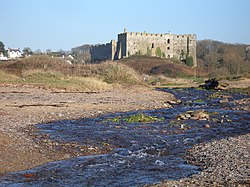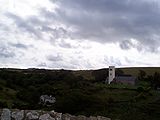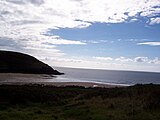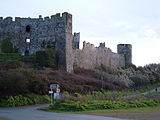Manorbier: Difference between revisions
Created page with "{{Infobox town |name=Manorbier |county=Pembrokeshire |picture=Manorbier Castle 3.jpg |picture caption=Manorbier Castle |os grid ref=SS066978 |latitude=51.644444 |longitude=-4..." |
m clean up, typos fixed: Bronze age → Bronze Age |
||
| Line 22: | Line 22: | ||
Fossils can be found along the stream bed, although some are of poor quality, and along the cliffs to the side of the beach the rock formations are revealed as vertical beds. The evidence of early human habitation consist of many flint microliths, housed in museums around the area, from the Mesolithic and Neolithic ages. The King's Quoit cromlech is the most notable monument in the local area and is to be found to the south east of Manorbier bay and beach. | Fossils can be found along the stream bed, although some are of poor quality, and along the cliffs to the side of the beach the rock formations are revealed as vertical beds. The evidence of early human habitation consist of many flint microliths, housed in museums around the area, from the Mesolithic and Neolithic ages. The King's Quoit cromlech is the most notable monument in the local area and is to be found to the south east of Manorbier bay and beach. | ||
Later evidence points to occupation of The Dak with the finding of a perforated mace head as well as Bronze-age burial mounds on the Ridgeway. Fortifications also seem to have been prominent including an Iron Age enclosure near Manorbier station and the site of a multivallate, meaning multiple ditches, promontory fort at Old Castle Head where there are remains of hut platforms within the ditches. There are also some old lime kilns near the sites of quarries and a restored version in Mud Lane shows how they looked originally. There is also an area of strip lynchets and fields dating back to early Anglo-Saxon times and perhaps as early as the Bronze | Later evidence points to occupation of The Dak with the finding of a perforated mace head as well as Bronze-age burial mounds on the Ridgeway. Fortifications also seem to have been prominent including an Iron Age enclosure near Manorbier station and the site of a multivallate, meaning multiple ditches, promontory fort at Old Castle Head where there are remains of hut platforms within the ditches. There are also some old lime kilns near the sites of quarries and a restored version in Mud Lane shows how they looked originally. There is also an area of strip lynchets and fields dating back to early Anglo-Saxon times and perhaps as early as the Bronze Age, which is to the east of the town alongside the road to Lydstep. There is a higher concentration near Manorbier Newton to the north west. | ||
== Tourism == | == Tourism == | ||
Latest revision as of 19:50, 28 January 2016
| Manorbier | |
| Pembrokeshire | |
|---|---|
 Manorbier Castle | |
| Location | |
| Grid reference: | SS066978 |
| Location: | 51°38’40"N, 4°47’53"W |
| Data | |
| Post town: | Tenby |
| Postcode: | SA70 |
| Dialling code: | 01834 |
| Local Government | |
| Council: | Pembrokeshire |
| Parliamentary constituency: |
Carmarthen West and South Pembrokeshire |
Manorbier is a village and parish on the south coast of Pembrokeshire. The name means the 'Manor of Saint Pyr'. The village is served by Manorbier railway station on the West Wales Line.
History
The Norman knight Odo de Barri was granted the lands of Manorbier, Penally and Begelly in gratitude for his military help in conquering Pembrokeshire after 1103. The first castle was motte-and-bailey style, with the stone walls being added in the next century by later Normans. Giraldus Cambrensis, son of William de Barri, was born in the village in 1146, and called it "the pleasantest place in Wales".[1]
Fossils can be found along the stream bed, although some are of poor quality, and along the cliffs to the side of the beach the rock formations are revealed as vertical beds. The evidence of early human habitation consist of many flint microliths, housed in museums around the area, from the Mesolithic and Neolithic ages. The King's Quoit cromlech is the most notable monument in the local area and is to be found to the south east of Manorbier bay and beach.
Later evidence points to occupation of The Dak with the finding of a perforated mace head as well as Bronze-age burial mounds on the Ridgeway. Fortifications also seem to have been prominent including an Iron Age enclosure near Manorbier station and the site of a multivallate, meaning multiple ditches, promontory fort at Old Castle Head where there are remains of hut platforms within the ditches. There are also some old lime kilns near the sites of quarries and a restored version in Mud Lane shows how they looked originally. There is also an area of strip lynchets and fields dating back to early Anglo-Saxon times and perhaps as early as the Bronze Age, which is to the east of the town alongside the road to Lydstep. There is a higher concentration near Manorbier Newton to the north west.
Tourism

Modern day Manorbier has become well known as a tourist spot and as a surfing site. Attractions in the village include Manorbier Castle, and a popular beach in the cove about half a mile to the south west of the village. Manorbier lies in the Pembrokeshire Coast National Park and on the Pembrokeshire Coast Path, and there are plenty of places for people to stay including Manorbier Country Park.
-
Manorbier Church
-
Manorbier Beach
-
Manorbier Castle
Twinned towns
Manorbier is twinned with Vernou-la-Celle-sur-Seine, France.
In Popular Culture
"Manorbier" is the title of an instrumental track on the album Rewind the Film by rock band Manic Street Preachers, whose bassist and lyricist Nicky Wire often holidays in nearby Tenby.[2]
References
- ↑ Manorbier Castle
- ↑ Nicky Wire, The Guardian, Friday 25 May 2012, Wales Coast Path - a postcard from Tenby by the Manics' Nicky Wire, http://www.theguardian.com/travel/interactive/2012/may/25/wales-manic-street-preachers-tenby


